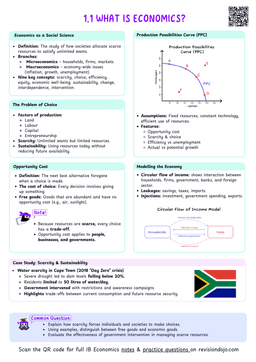Significance of Different Barriers to Economic Growth and/or Economic Development
- Economic growth and development are complex processes influenced by a wide range of factors.
- While some countries experience rapid progress, others face significant barriers that hinder their advancement.
- Understanding these barriers is crucial for identifying effective strategies to overcome them.
Economic Barriers
Rising Economic Inequality
- Economic inequality refers to the uneven distribution of income and wealth within a society.
- In many economically less developed countries (ELDCs), a small elite controls a disproportionate share of resources, leaving the majority with limited access to education, healthcare, and capital.
- In South Africa, the Gini coefficient, a measure of income inequality, is one of the highest in the world.
- Despite being one of Africa’s largest economies, the benefits of growth have not been evenly distributed, leading to persistent poverty and social unrest.
- Inequality can stifle economic development by:
- Reducing Human Capital: Limited access to education and healthcare for the poor lowers productivity and innovation.
- Creating Social Unrest: High inequality can lead to instability, deterring investment.
- Hindering Economic Growth: When a large portion of the population lacks purchasing power, domestic demand remains weak.
Lack of Access to Infrastructure and Appropriate Technology
- Infrastructure, such as roads, telecommunications, and energy systems, is essential for economic activity.
- Inadequate infrastructure limits productivity, increases costs, and reduces competitiveness.
- In Nigeria, frequent power outages disrupt businesses and discourage foreign investment.
- The lack of reliable electricity is a major barrier to industrial growth and job creation.
- Similarly, a lack of access to modern technology hinders productivity and innovation.
- Many ELDCs rely on outdated, labour-intensive methods, which are inefficient and limit economic growth.
Investments in infrastructure and technology can have a multiplier effect, boosting productivity across multiple sectors.
Low Levels of Human Capital
- Human capital, skills, education, and health of the workforce, is a critical driver of economic development.
- In many ELDCs, poor access to education and healthcare results in low productivity and high unemployment.
In Zimbabwe, high rates of HIV and maternal mortality severely impact labour productivity.
Additionally, limited access to quality education restricts opportunities for skill development.
- Investing in human capital can:
- Increase Productivity: A healthier, more educated workforce is more efficient and innovative.
- Enhance Economic Growth: Higher productivity leads to increased output and income.
- Break the Poverty Cycle: Education and healthcare investments can help future generations escape poverty.
Dependence on Primary Sector Production
- Many ELDCs rely heavily on the primary sector (agriculture, mining, etc.) for income. This dependence creates several challenges:
- Price Volatility: Primary commodities often experience significant price fluctuations, leading to unstable incomes.
- Limited Value Addition: Raw materials generate less income than processed goods.
- Environmental Degradation: Over-reliance on natural resources can lead to depletion and long-term sustainability issues.
- In Chad, over 50% of GDP comes from agriculture.
- However, climate change and poor infrastructure make the sector highly vulnerable, limiting economic growth.
Lack of Access to International Markets
- Global trade can drive economic growth by providing access to larger markets and encouraging specialization.
- However, many ELDCs face barriers such as tariffs, quotas, and protectionist policies that limit their ability to compete internationally.


